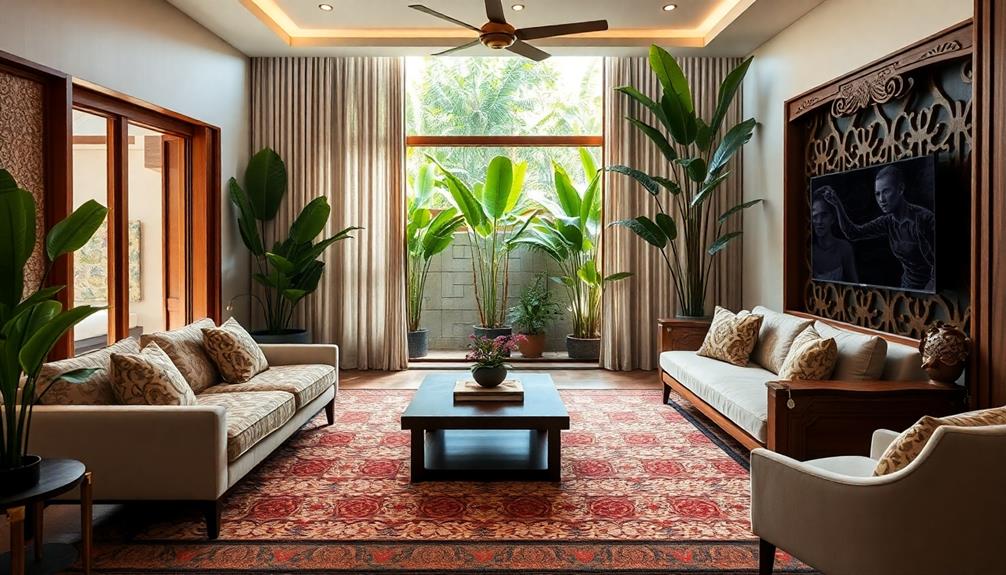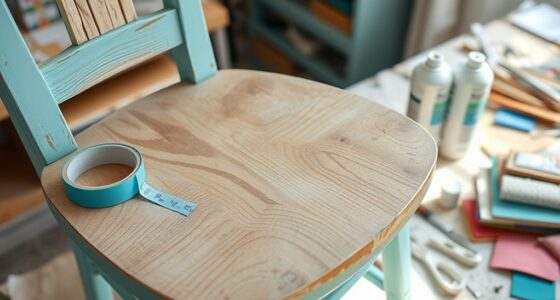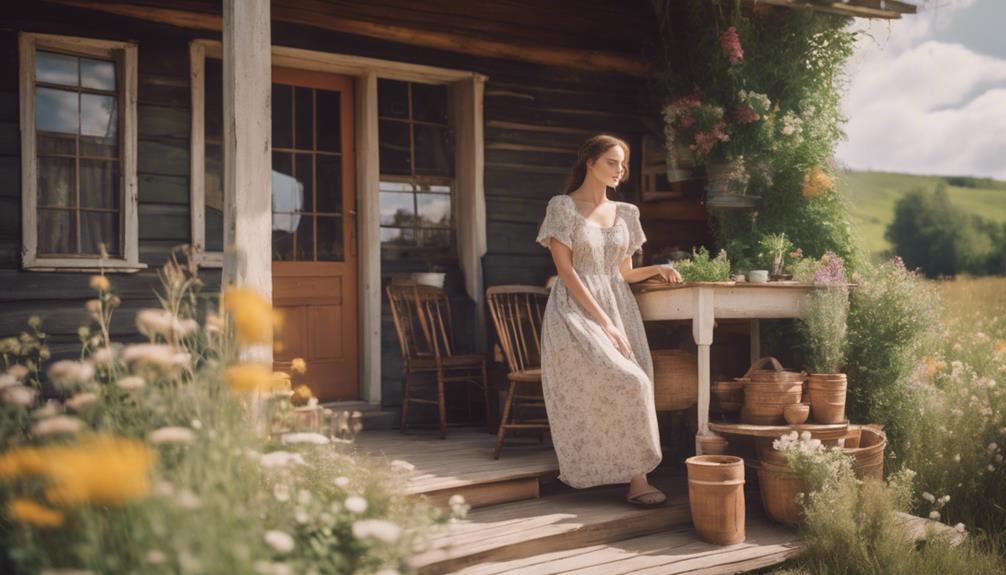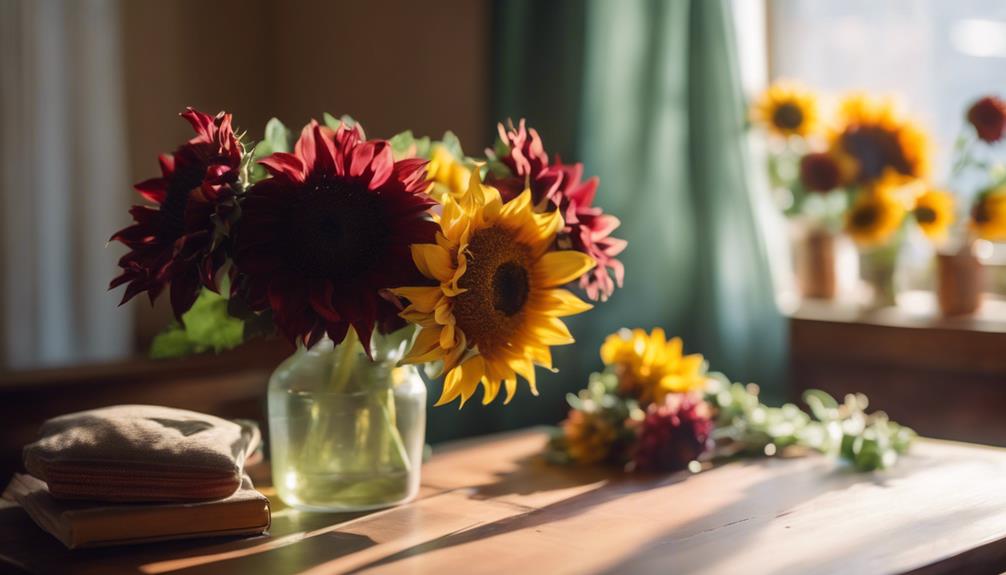Integrating traditional Indonesian design into modern interiors creates a rich, inviting atmosphere. You can use vibrant colors inspired by local textiles, like deep blues and earthy tones, to add warmth. Incorporate natural materials such as bamboo and rattan for texture and comfort. Select intricate décor pieces, like Indonesian masks or detailed carvings, to tell a story while maintaining balance with contemporary elements. When doing this, consider the scale of furniture to fit your space harmoniously. With a thoughtful approach, your interior can reflect cultural heritage while embracing modern aesthetics. There's more to explore on this enchanting design journey.
Key Takeaways
- Blend traditional Indonesian elements, like batik textiles and wood carvings, with modern designs for a harmonious aesthetic.
- Prioritize natural materials such as teak and bamboo to enhance warmth and durability in interiors.
- Use a neutral color palette to allow bold Indonesian pieces to stand out while maintaining visual cohesion.
- Incorporate unique decor items, like Indonesian masks and lanterns, to add cultural depth and character to spaces.
- Assess room dimensions and scale furniture appropriately to ensure balance and harmony within the design.
Overview of Indonesian Design
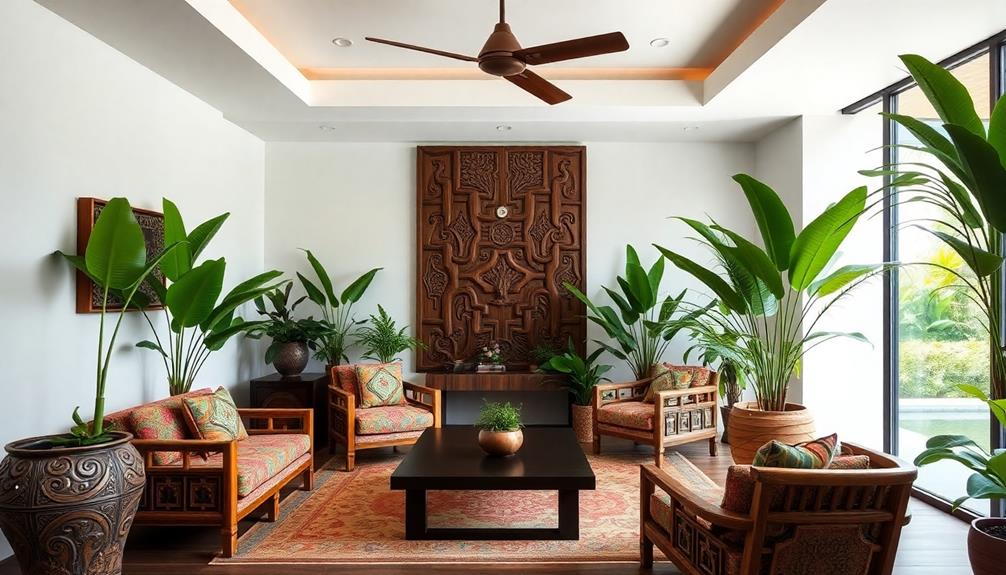
Indonesian design embodies a rich tapestry of culture and tradition that seamlessly blends with modern aesthetics. You'll find that traditional elements, like Balinese motifs and Javanese batik patterns, are intricately woven into contemporary spaces, creating an inviting atmosphere.
This design approach emphasizes harmony with nature, utilizing natural materials such as wood and bamboo, which reflect the region's rich cultural heritage and craftsmanship. Additionally, incorporating Indonesian decorative pillows can enhance the comfort and aesthetic appeal of your living spaces, emphasizing vibrant colors and intricate patterns.
As you explore Indonesian interiors, vibrant colors inspired by local textiles and landscapes catch your eye—think rich reds and earthy tones that foster warmth and energy. Traditional Indonesian textiles, including detailed batik prints, play an essential role in home decor, adding cultural identity and visual interest with their intricate patterns.
The guiding principle of trihaida karana, which focuses on balance among humans, nature, and the Divine, greatly influences how spaces are arranged and textured.
Key Elements of Indonesian Aesthetics

Rich colors and intricate designs define the key elements of Indonesian aesthetics. You'll notice vibrant hues inspired by local textiles, with rich reds, deep blues, and earthy tones weaving a tapestry that reflects the archipelago's cultural diversity.
These colors create an inviting atmosphere, making your space feel warm and alive. Furthermore, traditional artistry is evident in the unique designs of Indonesian decor masks, which enhance the overall aesthetic appeal of any room.
Intricate craftsmanship is another hallmark of Indonesian design. You'll find detailed wood carvings and handcrafted ornaments that narrate stories from mythology and daily life, adding a unique character to your interiors.
Embracing natural materials like rattan, bamboo, and antique wood fosters a connection to nature and promotes sustainable design practices.
Traditional textiles, especially batik prints, play an essential role in this aesthetic. You can easily incorporate them into your modern interiors through upholstery, cushions, and wall hangings, enriching your space with cultural identity.
Lastly, Indonesian design principles emphasize harmony and balance. By following concepts like trihaida karana, you prioritize the relationship between humans, nature, and the divine in your spatial arrangements.
This holistic approach guarantees that your interiors resonate with the essence of traditional Indonesian aesthetics while remaining contemporary.
Selecting Indonesian Furniture
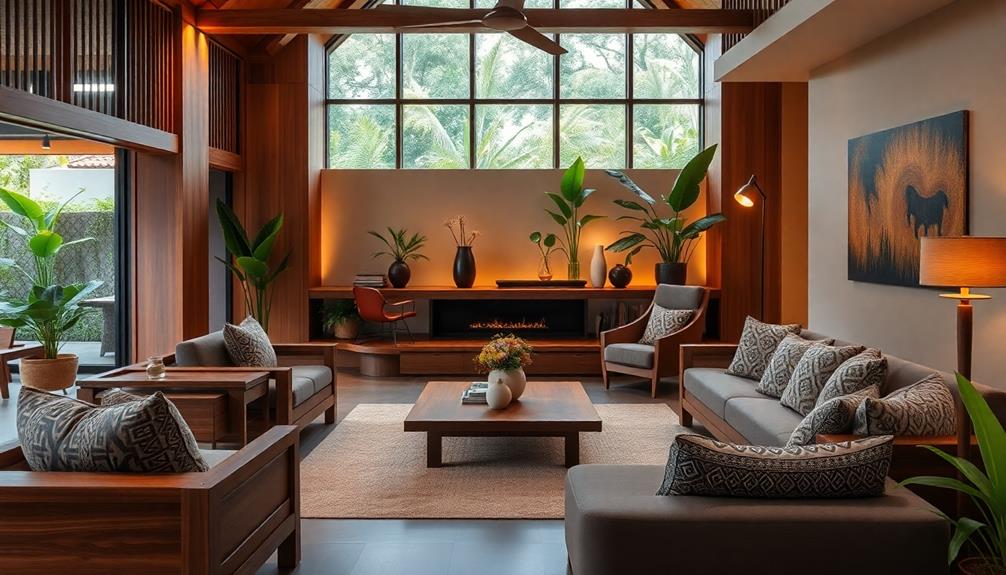
When you select Indonesian furniture, focus on scale and proportion to guarantee each piece fits perfectly in your space.
Consider the quality of materials like teak or mahogany, as these are commonly used by Mahallati Interiors for luxury tropical designs, and pay attention to color harmony to create a seamless look.
Scale and Proportion Considerations
Selecting the right scale and proportion of furniture is essential for creating a harmonious interior. When you choose traditional Indonesian pieces, consider their size in relation to your room's dimensions. Confirm that the scale of the furniture fits comfortably within the space, enhancing it rather than overwhelming it. Incorporating items like a Face Indonesian Decor Mask can also bring rich cultural accents to your decor.
If you mix various sizes, pay attention to how they interact with each other to avoid an awkward arrangement that disrupts the overall aesthetic. Aim for a balance between larger, bold Indonesian furniture, like a carved wooden table, and smaller, understated items, such as slim accent chairs. This mix creates visual harmony and maintains a cohesive look throughout the room.
Additionally, assess the height and bulk of each piece relative to your ceiling height and room layout. Low-profile furniture can make a space feel more open, while taller items can draw the eye upward, adding a sense of grandeur.
Incorporating traditional Indonesian design with thoughtful scale and proportion not only elevates your space but also invites comfort and style into your home. Keep these considerations in mind, and you'll achieve a beautifully arranged interior.
Material and Color Harmony
Incorporating traditional Indonesian design into modern interiors goes beyond just considering scale and proportion; the materials and colors you choose play a significant role in achieving harmony. Prioritize natural materials like teak and rattan, which reflect Indonesia's cultural heritage while providing durability and warmth.
When selecting furniture, think about a vibrant color palette inspired by local textiles. Rich reds, deep blues, and earthy tones can create energy and visual appeal, harmonizing with your overall decor.
| Material | Color Palette |
|---|---|
| Teak | Rich Reds |
| Rattan | Deep Blues |
| Batik Prints | Earthy Tones |
Make certain the furniture complements existing colors and textures, aiming for a cohesive look that balances traditional Indonesian aesthetics with contemporary design. Additionally, incorporate unique handcrafted elements, such as intricate carvings or batik prints, to enhance cultural identity while maintaining a modern aesthetic. Finally, assess the scale of your furniture to guarantee it fits comfortably within your space, avoiding oversized pieces that can disrupt the design balance. This thoughtful approach to material and color harmony will elevate your interiors beautifully.
Functionality and Craftsmanship Evaluation
Evaluating the functionality and craftsmanship of Indonesian furniture is vital for creating a well-designed space. When selecting pieces, prioritize quality craftsmanship since many are handcrafted using traditional techniques that highlight the region's cultural heritage. This attention to detail guarantees each item isn't just a piece of furniture but a work of art.
Additionally, consider how these selections can blend with Balinese design characteristics that emphasize sustainability and a connection to nature.
Next, assess the functionality of the furniture to confirm it meets your specific needs. Consider how each piece serves its purpose—whether it provides adequate storage, comfortable seating, or suitable surface areas. Also, pay attention to the scale of the furniture; it should fit comfortably within your space to avoid overcrowding and maintain a harmonious layout.
Material selection is important as well. Opt for durable and sustainable materials like teak or rattan, which align with eco-friendly practices while complementing your décor.
Mixing Styles With Indonesian Pieces

While you might think blending traditional Indonesian design with modern interiors is challenging, it can actually create stunning results when done thoughtfully. Start by using a neutral color palette that allows bold Indonesian pieces to shine without overwhelming the space. Incorporate traditional elements like intricate carvings or batik textiles as accent pieces, enhancing your overall aesthetic while keeping a cohesive look.
Traditional Indonesian Style Home Decor emphasizes natural materials, which can further enhance the connection between modern and traditional elements.
Balance is key; use simpler Indonesian furniture designs alongside modern pieces to guarantee that ornate traditional items complement rather than clash with contemporary decor. This creates a harmonious blend that feels intentional.
Experimenting with layering textures adds depth; combine rich fabrics and handcrafted ornaments from Indonesian culture with sleek modern finishes for visual interest.
Don't forget the storytelling aspect of Indonesian design. Choose unique pieces that reflect your personal experiences or heritage, making your space not just visually engaging but meaningful too.
Assessing Your Space
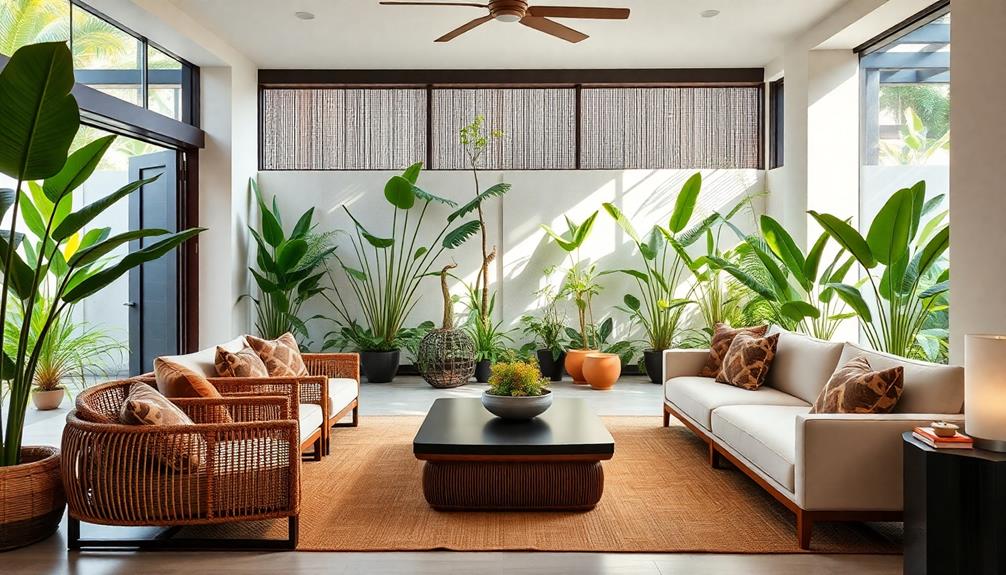
Start by evaluating your room dimensions to see how traditional Indonesian pieces, like large wooden furniture, can fit without crowding the space.
Consider integrating unique decor items such as Indonesian masks, which not only add cultural depth but also serve as a conversation starter.
Identify your personal style preferences, as this will guide you in selecting elements that not only enhance your decor but also reflect your taste.
Evaluating Room Dimensions
When you're ready to integrate traditional Indonesian design into your modern interiors, the first step is to measure your room dimensions accurately. Start by evaluating the length, width, and height of your space. This guarantees that your furniture pieces fit comfortably without overcrowding.
Remember, the scale of Indonesian furniture varies; larger items can dominate smaller rooms, while smaller pieces may get lost in expansive areas, disrupting your design principles. To enhance your decor, consider incorporating vibrant color palettes reflecting Indonesian culture, such as red, gold, and green, which can add a lively touch to your interior traditional decor inspiration.
Next, pay attention to ceiling height. Traditional Indonesian designs often feature tall structures and intricate carvings that require adequate vertical space to shine. Assess doorways and passages, too, as oversized furniture may not fit through standard openings, complicating your arrangement process.
Creating a floor plan is also essential. Visualize the placement of furniture within your room dimensions to achieve a balanced and cohesive integration of traditional elements with modern design features.
This step helps you understand how each piece will interact with your space, guaranteeing that your design reflects both functionality and aesthetic appeal. By carefully evaluating room dimensions, you're one step closer to harmonizing traditional Indonesian design with your contemporary interior.
Identifying Style Preferences
Identifying your style preferences is essential for successfully integrating traditional Indonesian design into your modern interiors. Start by evaluating the existing color palette in your space. Look for vibrant hues inspired by local textiles that can harmonize with your overall aesthetic.
Consider how to incorporate tropical color palettes that reflect the lush environment of Indonesia. Assess the scale and proportion of your room to guarantee that traditional Indonesian furniture fits comfortably without overwhelming the area.
Next, consider the texture and materials of your current decor. Incorporating natural materials like wood and bamboo from Indonesian design can enhance comfort and create a serene environment.
Reflect on your personal style preferences—whether you lean towards modern, traditional, or eclectic designs. This reflection will guide you in selecting Indonesian elements that resonate with your taste.
Common Mistakes to Avoid
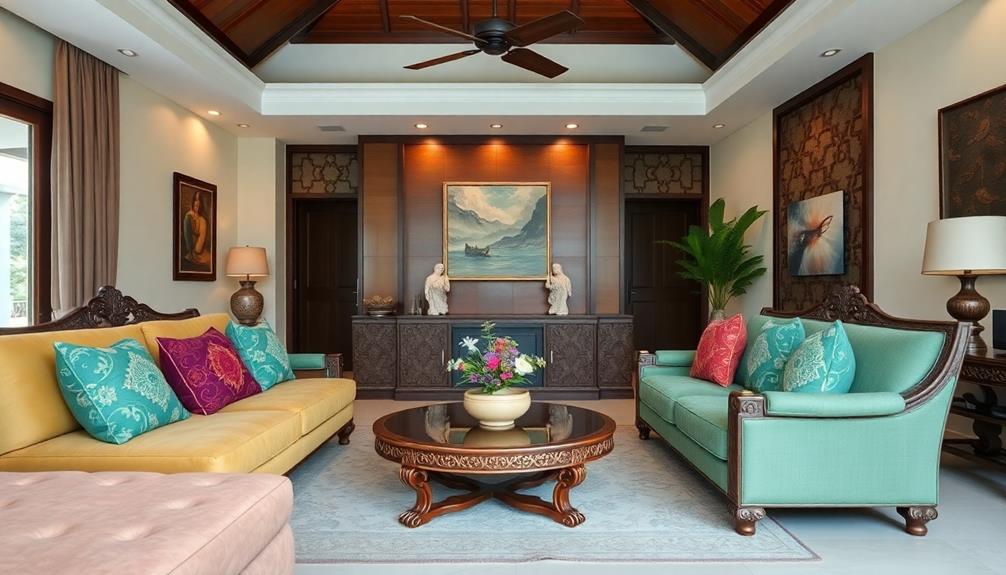
In the quest to blend traditional Indonesian design with modern interiors, avoiding common pitfalls is crucial for achieving a harmonious space. One major mistake is overwhelming your area with too many bold Indonesian design elements. This can disrupt the overall balance and aesthetic harmony of your interior.
Additionally, consider the importance of incorporating distinct architectural styles that resonate with the regional identity of Indonesia. Also, don't neglect cultural significance; misrepresenting traditional elements can lead to a diluted portrayal of the culture you're trying to honor.
Pay attention to the scale and proportion of Indonesian furniture and decor. Confirm they fit well within your existing space to prevent awkward arrangements and enhance functionality.
Clashing patterns and colors are another common issue. Stick to a consistent color scheme and carefully select complementary textiles and materials to maintain a cohesive look.
Enhancing Ambiance With Lighting
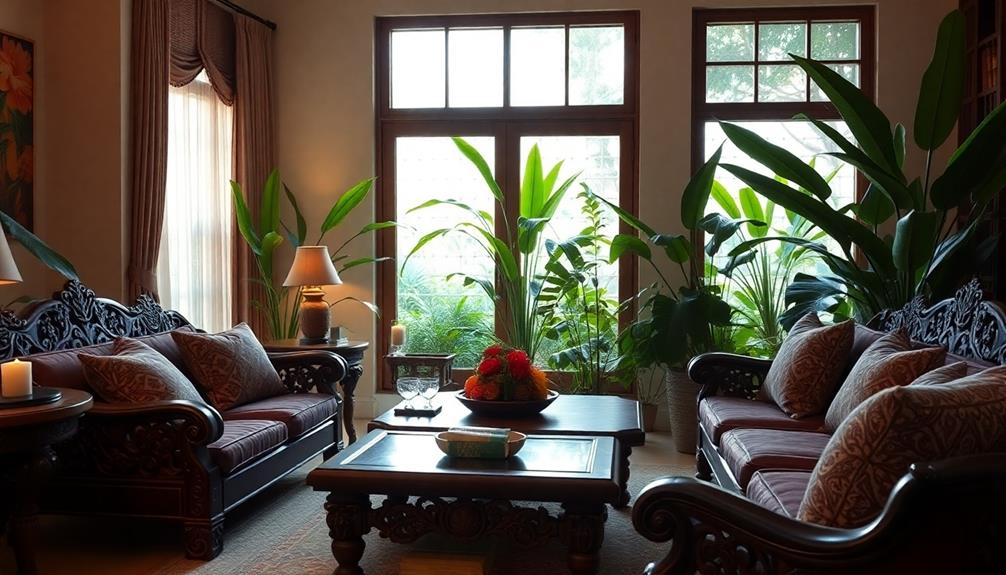
To create a truly inviting space that blends traditional Indonesian design with modern aesthetics, lighting plays a pivotal role. Proper lighting enhances the ambiance markedly, highlighting the intricate carvings and textures of your Indonesian furniture and decor. By utilizing warm-toned lighting, you can complement the rich color palette typical of these interiors, crafting a cozy and inviting atmosphere.
Incorporating layered lighting strategies is essential. Ambient lighting sets the general mood, while task lighting provides functionality for specific areas. Accent lighting showcases traditional textiles and materials, adding depth to your space.
Consider using traditional Indonesian lanterns or pendant lights as focal points; they infuse cultural authenticity and visual interest into modern interiors. Additionally, modern lighting fixtures with dimming capabilities allow you to control brightness levels easily, enhancing the serene and tranquil environment often associated with traditional Indonesian design.
Creating a Cohesive Look
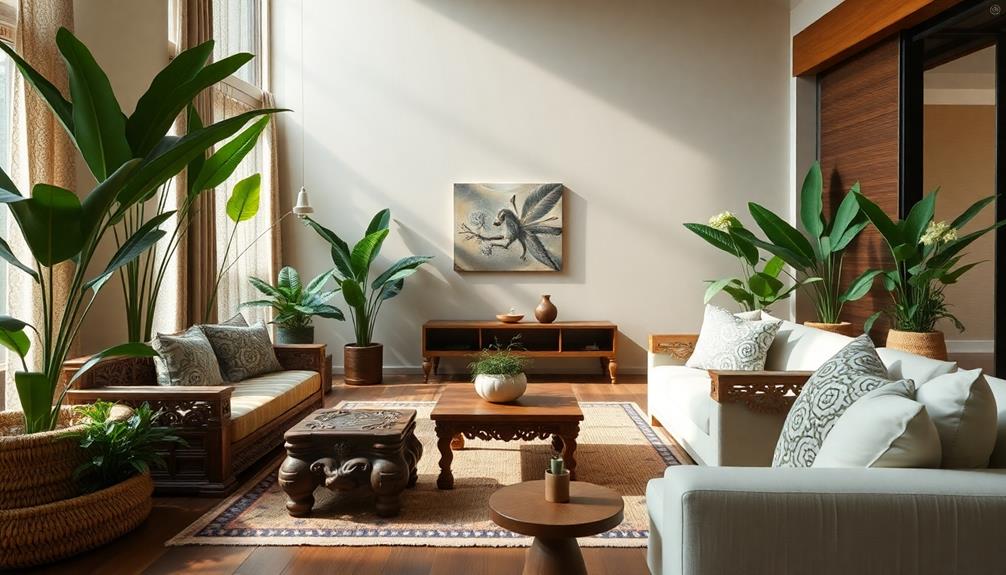
Achieving a cohesive look when blending traditional Indonesian design with modern interiors requires thoughtful planning and execution. Start with a neutral base, allowing vibrant Indonesian textiles and furniture to shine without overwhelming the space. Incorporate carved wooden pieces and batik textiles alongside minimalist modern designs to create harmony while maintaining cultural authenticity.
To further enhance the connection between elements, use a consistent color scheme reflecting the rich hues found in Indonesian art—deep reds, earthy tones, and vibrant blues. This approach ties various design elements together seamlessly. Balance ornate Indonesian furniture with simpler contemporary pieces to avoid visual clutter, ensuring each element complements rather than competes.
Emphasizing texture is also essential. Layer materials like rattan, bamboo, and wood to create depth and warmth, enhancing the overall cohesiveness of the design. Here's a quick reference table to guide you:
| Element | Traditional Style | Modern Counterpart |
|---|---|---|
| Color Scheme | Deep reds, earthy tones | Neutral tones |
| Furniture | Carved wooden pieces | Simple minimalistic pieces |
| Materials | Rattan, bamboo | Metal, glass |
Celebrating Cultural Heritage in Design

Blending traditional Indonesian design with modern interiors not only creates a unique aesthetic but also honors the rich cultural heritage of the archipelago. By incorporating intricate craftsmanship into your space, you celebrate the stories and traditions that define Indonesia.
Decorative accents often depict mythological figures and daily life scenes, enriching your environment with cultural significance.
Using a vibrant color palette inspired by local textiles and landscapes can further enhance this celebration. Rich reds, deep blues, and earthy tones resonate with the artistic traditions of the region, making your interior visually compelling.
Emphasizing natural materials like rattan, bamboo, and antique wood not only adds warmth and comfort but also supports sustainable practices. These elements create a serene atmosphere that reflects the harmony central to Indonesian design principles.
Integrating traditional textiles, such as batik prints and unique woven fabrics, infuses your space with cultural identity and visual interest.
Frequently Asked Questions
How Do You Combine Modern and Traditional Interior Design?
To combine modern and traditional interior design, start with a neutral base, mix natural materials, and incorporate textiles. Balance ornate pieces with simpler designs, ensuring each element complements the other for a harmonious look.
What Is the Combination of Traditional and Modern Design Called?
When you blend the old with the new, you create a tapestry of styles known as Transformational Design. It's like weaving a story where every thread, traditional or modern, tells a unique tale of harmony.
What Is Balinese Interior Design Style?
Balinese interior design style emphasizes open spaces and natural light, creating a harmonious flow between indoors and outdoors. You'll find intricate wood carvings, earthy tones, and natural materials that evoke warmth and connection with nature.
How Does Culture Affect Interior Design?
Imagine walking into a home inspired by Japanese Zen principles, where minimalist design promotes tranquility. Culture shapes interior design by influencing color, materials, and layout, creating spaces that reflect values and heritage.
Conclusion
By weaving traditional Indonesian design into your modern interiors, you're crafting a vibrant tapestry that celebrates both heritage and contemporary style. Remember, it's all about balance—let the rich textures and colors of Indonesia shine while ensuring everything harmonizes. Avoid common pitfalls, and embrace the unique charm each piece brings. As you enhance your space, you're not just decorating; you're telling a story that bridges cultures and time, creating a home that feels both rooted and alive.
